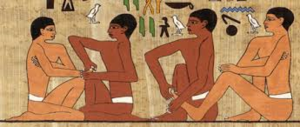What is Reflexology?
Reflexology is the name given for the technique of applying pressure through massage to different reflex points on the feet or hands, in order to bring about a state of deep relaxation.
Reflexology is based on the belief that specific points on the feet are linked to either an organ, system, or part of the body, and by applying gentle pressure to those reflex points you create a reaction in the body. Reflexology can improve mood, aid sleep and promote a sense of wellbeing.
The therapy is completely non invasive and can be experienced and enjoyed by children and adults alike.
History and origins of reflexology
Reflexology as a therapy is thought to be over 4,000 years old. The oldest known documentation of reflexology comes from a pictograph in the tomb of Ankhmahor (2500-2330 B.C.).The pictograph shows people receiving hand and foot massages, asking that the massages ‘give strength’ and ‘do not cause pain’.
Sir Henry Head was an English neurologist practicing in the 1890s. He discovered that certain areas, or ‘zones’, of the skin reflected different organs of the body. If there was pain/illness in the body, it would be reflected in its corresponding zone on the skin, which he coined ‘Head zones’.
Dr William Fitzgerald, an American surgeon in the early 20th century was another pioneer who took Sir Henry Head’s theories further and developed ‘zone therapy’ as we understand it today. He delivered minor surgical procedures to patients without any anaesthetics, by applying pressure to different parts of the body/zones – the pressure acted as an anaesthetic to the patient and the surgical procedure didn’t cause pain. He also discovered that applying pressure to the zones relieved pain and in the majority of cases relieved the underlying cause as well.
Eunice Ingham is regarded as the founder of modern reflexology and spent her life practicing reflexology to inform the development of her theories. In the early 1930's, whist working as a physical therapist, she developed zone therapy into Reflexology, by placing all of the organs and structures of the body into different zones of the feet after months of careful ‘mapping’ of the body onto the feet. She also discovered deposits, or ‘crystals’, under the skin of the feet, and realised that by applying on/off pressure to the feet you produced a stimulating effect on the body which helped the body to function more effectively.
Today, reflexology is practised around the world, with an estimated 17 million therapists currently providing reflexology.


